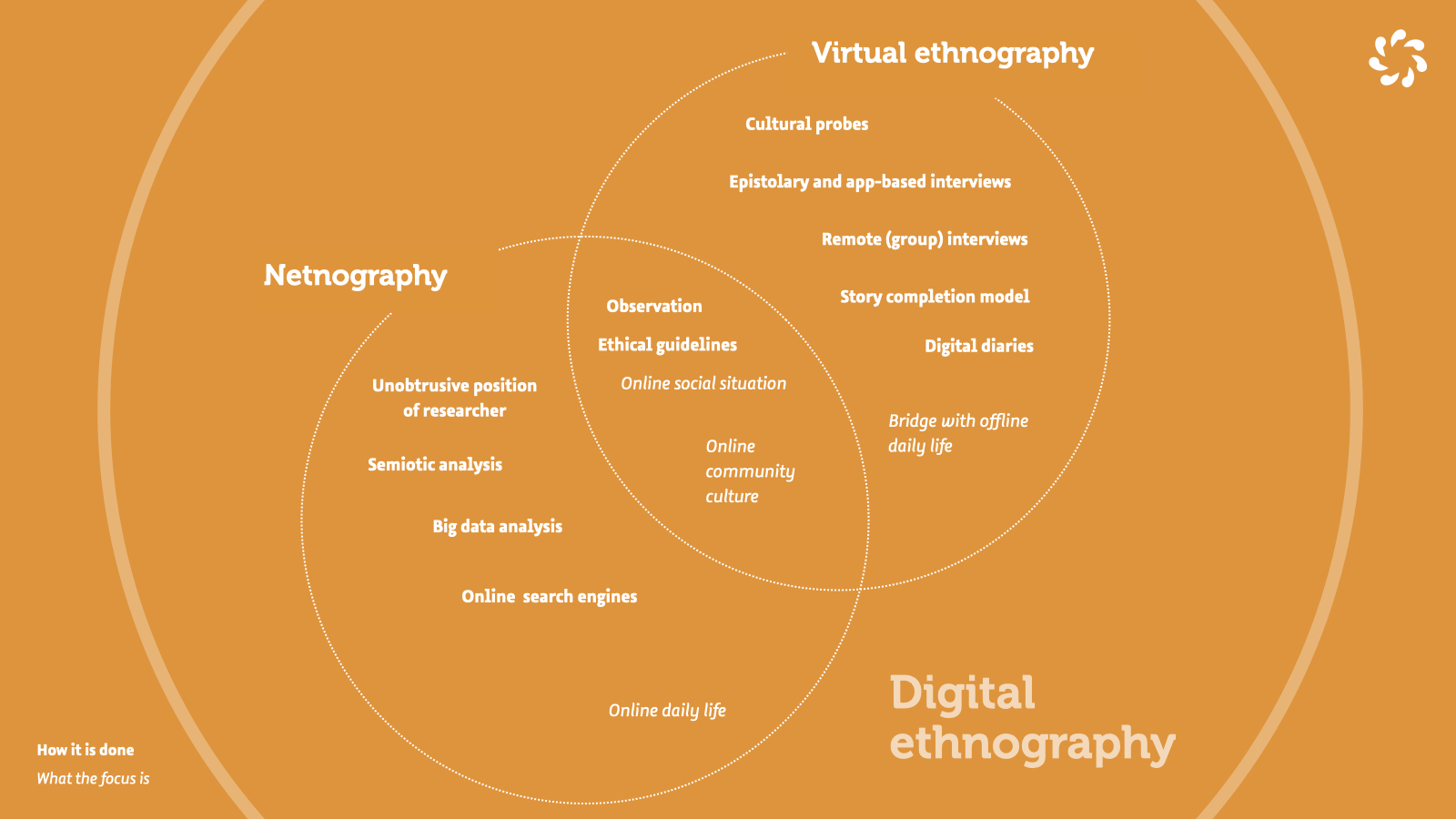How to gain impactful insights with remote user research?

In this article we explore how to conduct impactful applied qualitative research remotely, when we may not be able to conduct in-person interviews – as is the case now during the Covid-19 pandemic. Rather than pushing for particular technologies or tools, Experientia takes an insight-driven approach: not meeting in person can still deliver great insights and inform the design of human-centered products and services.
Experientia, since its foundation in 2005, has always placed people at the center of all its projects: the users of the services, digital and not, that need to be (re)designed. Qualitative user research has been central to that challenge.
Over the years our methods to do this have evolved and changed according to the changing contexts of the topic we are interested in, but also to the changing social conditions, which are increasingly moving online.
In recent years, our most consolidated research activities, such as shadowing and contextual interviews, have been improved by digital ethnography.
What is digital ethnography?
Digital media and technologies have become part of everyday life. Digital ethnography tackles this digital dimension “both as a space for social interactions and as a cultural space and product that has promoted practices, phenomena and multiple social identities” (Suarez, 2018).
Conceptually, digital ethnography is an umbrella term that includes virtual ethnography and netnography.
Netnography collects data related to the study using various online tools. It studies (or observes) the online social behavior of individuals.
Virtual ethnography also implies the observation of online social situations and community cultures, but goes further by taking a more interactive and collaborative approach to study the individuals’ social behavior through direction interaction by means of digital technologies.

The Experientia approach
The skills Experientia developed in recent years on netnography and virtual ethnography provided us with the knowledge and expertise to develop a framework that outlines which methods and tools to use when doing online qualitative research. We presented it at IxDa Interaction 2020 Conference in Milan this year.
Our approach to digital ethnography, sometimes integrated with other research methods, allow us not only to reach out to people all over the world in a short time, but also to create optimal conditions to investigate our offline, online and hybrid lived experiences.
How to best apply technologies to remote ethnographic research?
While digital media and technologies allow us to shorten times and distances and to communicate and share files, they also have barriers due to reasons that are cultural (the use or not of certain technologies), generational (especially in some countries, elderly do not use smartphones, computers, etc.) and physical (e.g. disabilities such as blindness, motor dysfunctions, etc.). The pros and cons of the various technologies need to be analyzed during the research setup, in order to develop the best strategy for a particular research focus. But luckily digital technologies are usually flexible enough for the researcher to be able to continuously calibrate the research methodologies according to the participants’ needs.
Methods
Researchers can use a variety of strategies and methods to gain impactful insights. Which technologies and methods to adopt when?
The netnography method
Netnography allows researchers to collect rough data, by directly observing free, online contents such as videos, photos, posts and related conversations on social media, networks, forums and so on. By capturing such information and analyzing it in a structured way, netnography allows us to describe and model the online behaviors of a particular community. Considering that this is a primarily observational method, it also ensures researcher’s anonymity. Netnography is a good method, which allows to access big data, also examining it through the lens of semiotic analysis.
Methods to conduct virtual ethnography
Virtual ethnography offers many methods to conduct research. Here we suggest some of them, those we consider the most effective:
Cultural probes – Coming from design research, this method uses kits of material to be completed by research participants and, once ready, sent back to the researchers. Traditionally, these probes are analogue, but researchers can also develop them digitally and use social apps (like Instagram) and emails to communicate with participants. Cultural probes are a valid method that still needs to be integrated with others in order to arrive at a comprehensive understanding of participants. In this sense, photo, video, voice elicitation is a solid way to improve information. It requires participants to use a camera or a voice recorder to take photos, shoot videos or record voice memos about their everyday lives. Often conducted by smartphone, it allows researchers to receive live updates and cut out time and distances.
Epistolary and app-based interviews – Epistolary interviews are asynchronous, one-to-one interviews mediated by technology. As interviewers and participants are not co-present, this method allows both to select the most suitable time for the interview. It permits them to evaluate questions and responses, and eliminates the need for transcription. Besides email, such interviews can also be conducted on apps such as WhatsApp, Telegram, Skype.
Remote (group) interviews – Interviews collect first-hand personal accounts of experiences, opinions, attitudes and perceptions. Interviews can be structured and follow a script of questions, or can be relatively unstructured, allowing for flexible detours in a conversation format. Online interviews should be seen as a backup when there is no opportunity to meet in person for an offline interview. Moreover, with technologies such as Skype, Zoom, Whereby, Jitsi Meet and so on, researchers can also conduct group interviews and easily record them.
Story completion model and online form – Story completion is a writing method implying the completion of a story, that can also be conducted using online tools such as SurveyMonkey, Google/Microsoft forms, and OnlineSurveys.ac.uk, etc. Alternatively, researchers can rely on emails to send the prompts to participants to be completed at home and then sent back.
Digital diaries – Generally constructed for questionnaires or free-flowing reflections, diaries give detailed insight into the daily experiences of users in their cultural context. Smartphones or online platforms make this method less intrusive and easy to combine with everyday practices, providing more opportunities to gather accurate information. Moreover, researchers can constantly monitor the diaries and set tasks for participants.
Conclusion
Digital technologies and media are powerful tools that allow researchers to access information and connect with users and participants around the world, but they must be based on a grounded research strategy, used in a structured way, and, above all, follow ethical guidelines. There is no standard method or universal strategy for tackling digital ethnography research, each topic requires a personalized one.
References
- Boellstorff T. et al (2012) Ethnography and Virtual Worlds: A Handbook of Method, Princeton University Press,
- Hine C. (2015) Ethnography for the Internet: Embedded, Embodied and Everyday,
- Hine C. (1994) Virtual ethnography, 3th International Conference on Public Communication of Science and Technology (PCST), Montreal,Canada,10-13 April,1994,
- Horst H. Miller D. (2013) Digital Anthropology, Bloomsbury Academic,
- Kozinets R. (2015) Netnography: Rede!ned, SAGE Publications,
- Lupton D. (2020) Doing fieldwork in a pandemic,
- Pink. S. (2017) Sensory Ethnography in a Digital Material World, Culture and the Senses, German Folklore Association,
- Pink S. (2015) Digital Ethnography: Principles and Practice. SAGE Publications,
- Salganik M.J. (2018) Bit by bit, Princeton University Press,
- Suarez M. (2018) What can multi-sited and digital ethnography contribute to innovation studies in the global South in African Journal of Science, Technology,Innovation and Development,
- Underberg N.M. (2013) Digital Ethnography: Anthropology, Narrative, and New Media, University of Texas Press.



